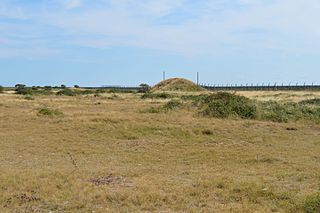
Castle Point is a local government district with borough status in south Essex, 30 miles (48 km) east of central London. The borough comprises the towns and villages of Canvey Island, Hadleigh, South Benfleet, and Thundersley. The borough council is situated at Thundersley.

Oxleas Wood is one of the few remaining areas of ancient deciduous forest in Eltham in the Royal Borough of Greenwich, in southeast London. Some parts date back over 8,000 years to the end of the last ice age, the Younger Dryas. It is part of a larger continuous area of woodland and parkland on the south side of Shooter's Hill: other parts are Jack Wood, Castle Wood, Oxleas Meadows, Falconwood Field, Eltham Common and Eltham Park North. Eltham Park North includes the ancient Shepherdleas Wood.

Thundersley is a town and former civil parish, now in the unparished area of Benfleet, in the Castle Point borough, in southeast Essex, England. It sits on a clay ridge shared with Basildon and Hadleigh, 31 miles (50 km) east of Charing Cross, London. In 1951 the parish had a population of 6482.

Ingrebourne Valley is a local nature reserve (LNR) in Hornchurch in the London Borough of Havering. It is owned and managed by Havering Council, and has a visitor centre managed by the Essex Wildlife Trust. Most of it is in Hornchurch Country Park west of the River Ingrebourne, but there are also areas north and south of the park which are part of the LNR. It has a wide range of habitats, including woodland, grassland, the river and marshes. It is an important site for a range of species of plants, animals and birds, including great crested newts, slow worms, the harvest mouse and the water vole.

The Chingford Reservoirs are the King George V Reservoir and the William Girling Reservoir, which form part of the Lee Valley Reservoir Chain in the London Boroughs of Enfield and Waltham Forest and Epping Forest in Essex. Construction of the King George V Reservoir was started in 1908 and completed in 1912. Work on the William Girling Reservoir was started in 1938, with John Mowlem & Co being the contractor, but owing to technical problems, and the intervention of World War II, the reservoir was not finished until 1951.

Ingrebourne Marshes are a 74.8 hectare biological Site of Special Scientific Interest in Hornchurch in the London Borough of Havering. Ingrebourne Valley Local Nature Reserve includes a small part of the SSSI west of the River Ingrebourne. The site is managed by the Essex Wildlife Trust

Riddlesdown Common or Riddlesdown is a 43 hectare area of green space in Kenley, towards the northern end of the North Downs in the London Borough of Croydon. It is owned and maintained by the City of London Corporation, apart from two small areas, one of which is operated by the London Wildlife Trust and the other by Croydon Council. An area of 32 hectares is a biological Site of Special Scientific Interest. The name Riddlesdown also applies to the local district of residential housing. A trig point at the site indicates that it is 525 ft (160 m) above sea level.

Bixley Heath is a 5.1-hectare (13-acre) biological Site of Special Scientific Interest on the eastern outskirts of Ipswich in Suffolk. It is also a Local Nature Reserve owned and managed by Ipswich Borough Council.

Bricket Wood Common is a 70 hectare open space and biological Site of Special Scientific Interest in Bricket Wood in Hertfordshire. It is managed by St Albans City and District Council together with the Countryside Management Service and Bricket Wood Joint Management Committee.

Curtismill Green is a 47.3-hectare (117-acre) biological Site of Special Scientific Interest between Epping and Brentwood in Essex. It is registered common land. A report by Essex County Council in 2007 stated that the site was in multiple ownership, and it was in poor condition.

Danbury Ridge Nature Reserves are a group of nature reserves totalling 101 hectares near Danbury in Essex, England. They are managed by the Essex Wildlife Trust, and most of them are in Sites of Special Scientific Interest (SSSIs). Two areas, the Backwarden and Hitchcock's Meadow, are part of Danbury Common SSSI, and Woodham Walter Common, Birch Wood, Pheasanthouse Wood, Poors Piece, Scrubs Wood, and a small area in Pheasanthouse Farm, are part of Woodham Walter Common SSSI.

Garrold's Meadow is a 5 hectare biological Site of Special Scientific Interest north of Leigh-on-Sea in Essex. The local planning authority is Castle Point Borough Council.

Harlow Woods is a 47.1-hectare (116-acre) biological Site of Special Scientific Interest in Harlow in Essex. It is composed of three woods, Hospital Wood Risden's Wood and Parndon Wood. They are owned and maintained by Harlow District Council, and they are part of the slightly larger Parndon Woods and Common Local Nature Reserve.

High Wood, Dunmow is a 41.5-hectare (103-acre) biological Site of Special Scientific Interest in Great Dunmow in Essex. The local planning authority is Uttlesford District Council.

Thorndon Park is a 141.4-hectare (349-acre) biological Site of Special Scientific Interest in Brentwood in Essex. Part of it is run by Essex County Council as Thorndon Country Park, and the Essex Wildlife Trust manages its visitor centre.

Shoeburyness Old Ranges or Shoebury Ranges is a 6.4 hectare Local Nature Reserve in Shoeburyness in Essex. It is part of the Foulness Site of Special Scientific Interest, and of the Gunners Park and Shoebury Ranges nature reserve, which is managed by the Essex Wildlife Trust.

Abbotts Hall Farm is a 282 hectare nature reserve in Great Wigborough in Essex. It is the head office of the Essex Wildlife Trust, which manages the site. It is also part of the Blackwater Estuary National Nature Reserve, Site of Special Scientific Interest, Ramsar site, Special Protection Area and Special Area of Conservation, It is an important archaeological site, and includes a Scheduled Monument, Great Wigborough henge.

















